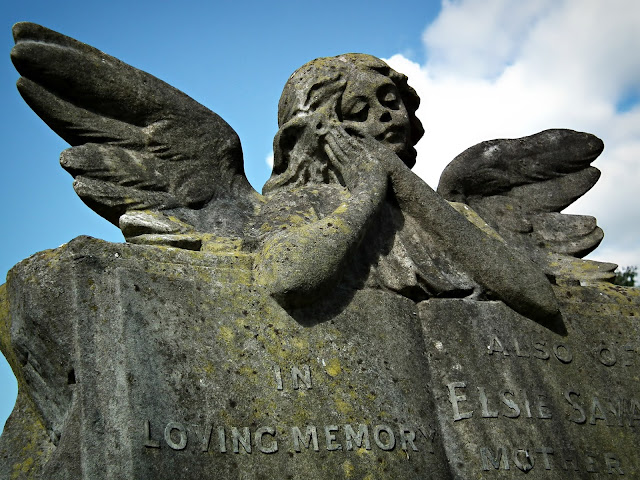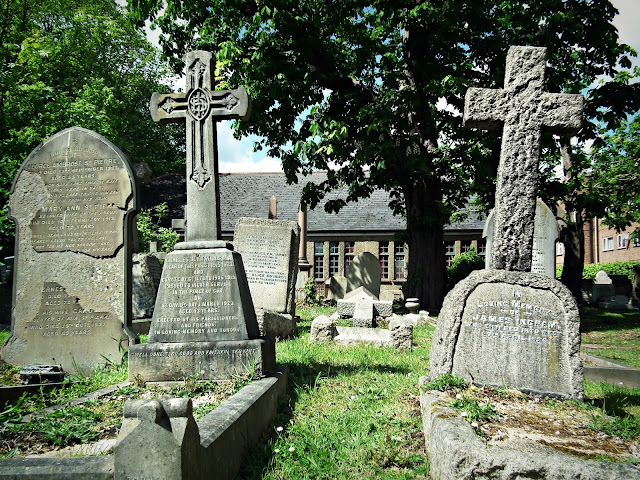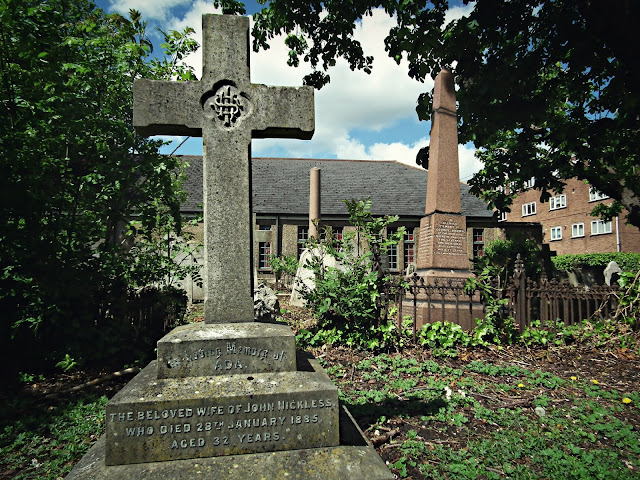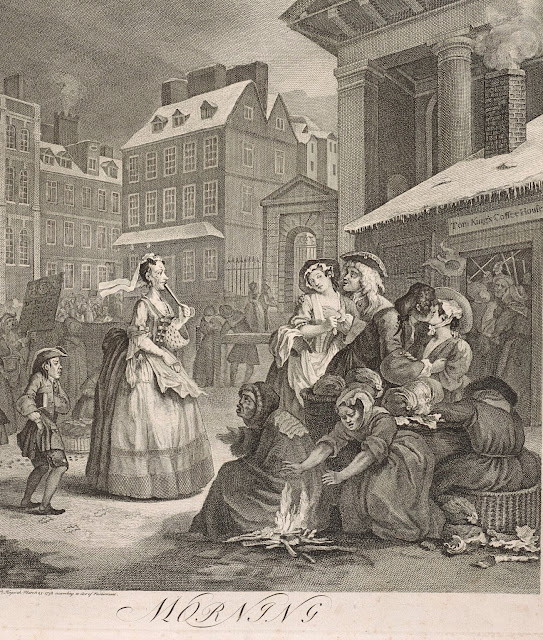
The
first burial in the churchyard in the present register took place in 1840. By
an unfortunate oversight, the earlier burials seem to have been mostly in the part
of the churchyard near the road, and thus, as the pariah increases, the finer
and more ornamental tombs have had to be placed at the back of the church.
Could the position have been reversed, and the finest tombs placed near the
road, the appearance of the church from the Vicarage and from the road would have
been more pleasing, for some of these tombs are among the prettiest works of
art in the parish, which is not perhaps saying much for the aesthetic taste of
local builders. The parish church was built at a bad period -1840- and its
style is a somewhat corrupt kind of Norman. There is a striking difference
between this building and the real Norman - take for instance St. Bartholomew
the Great at Smithfield. After all it
has a simple effect, and after London smoke, visitors from town admire its
cleanly cream colour and simple decoration, Perhaps, as the Twentieth Century
advances. and the true principle, of "art as the hand maid of
religion," become more fully realised, it will be made more worthy of its
position. Internally, also, it lacks architectural beauty.
Essex Guardian - Saturday 11
April 1903
Holy
Trinity, Barkingside is the sort of building Pevsner inevitably had something disparaging
to say about. If I could find my copy of the ‘Buildings of England – Essex’ I
would tell you what it was but I seem to have mislaid it somewhere. The
anonymous author of the 1903 Essex Guardian series ‘Where Ilford Goes on
Sunday’ (to church of course, where else?) reckoned that the parish “has such
an interesting history that the trouble is not how a find sufficient material, but
how to confine the facts at our disposal into the limited space one article.
Barkingside Parish Church, or Holy Trinity, Barkingside, to give it its full title,
is a fine old edifice, standing in the middle of the parish. It was built
nearly sixty years ago, and has a seating accommodation for about four hundred
people. The outer walls of the edifice are almost hidden from view by the mass
of ivy which has clung around it.” The ivy has gone and the ‘fine old edifice’
of 60 years is now 180 and has had a couple of facelifts. One added a chancel
in 1898 and the vestries were added sometime last century. The churchyard was
the only burial ground in the parish until 1923 when a new cemetery was opened
next door to serve the growing community. I came here looking for the grave of the
rather intriguing Reverend Wladislav Somerville Lach-Szyrma who was vicar of
Holy Trinity from 1890 until his death in 1915 but despite the small size of
the churchyard and the large size of his grave stone I was completely unable to
locate it. I required a second visit and the help of the current vicar to
finally track it down – but that is a story for another day.

Thanks
to the residents of Ilford who had written to the church commissioners in 1838,
requesting that a new church be built for the ‘very destitute and degraded’
people of Barkingside, Edward Blore’s yellow brick ‘corrupt kind of Norman’ church
was built in 1839-40 replacing an earlier church or chapel that was marked on
maps as Mosfoot Parish Church. The oldest headstone in the churchyard carries
the date 1790. Barkingside was a very rural parish, quite outside the ambit of
the capital, for most of the 19th century; in 1876 James Thorne said the
village was “merely a gathering of a few small houses along a crossroad, and a
few others by a scrubby green; the inhabitants are chiefly engaged in
agriculture.” He only noticed its existence because 3 years earlier Dr Barnado
had been given the lease of Mossford Lodge as a wedding present and had opened
his first home for girls there. The growth of the Barnado’s estate of children’s
homes seems to have acted as a catalyst for more general growth in the area. In
1903 Barkingside Station, which is now on the Central Line, was opened by the
Great Eastern railway. Memorials to the dead children of Barnado’s and to
victims of railway accidents are both features of the churchyard.
BARKINGSIDE.
The Church and Unbaptized Children — Some unpleasantness was caused in
Barkingside a few days since by the refusal of the Vicar (Rev. N. Perkins) to
bury the unbaptised child of James Vince. The child was eleven months old.
Through the intervention of friend of Vince’s, the Rev. W. Stepney, of Ilford,
undertook to officiate, and he conducted a funeral service in the Methodist
Free Church, and completed the service at the graveside.
Chelmsford Chronicle - Friday 27
September 1889

When
the Reverend Perkins wasn’t refusing to bury unbaptised children his illiterate
sexton was getting himself into trouble for burying still born babies without a
proper death certificate after accepting a scribbled note on a scrap of paper from
an unlicensed midwife as sufficient authority to carry out the interment:
A
WARNING TO SEXTONS. - In consequence of some irregularities in the burial of a
child at Barkingside, an inquest was held at the Maypole Inn, Barkingside, on
Wednesday before Mr. C. C. Lewis, upon the body of a child named Cross, aged
five days, son of Thomas Cross, a labourer. The father stated that his wife was
delivered of twins on the 5th inst. (Monday), and was attended by Mrs. Staff
(midwife). One of the children died on the following day, and the deceased died
on Saturday. The body of the former was delivered to F. Linsell (the Sexton at
Barkingside Churchyard) by the witness on Wednesday evening, and by him buried.
Linsell asked witness for a certificate, and he gave him the piece of paper
produced. This had written on it, "Baby died 5th August, 1889. Mrs.
Staff." Julia Staff stated that the deceased was seized with a fit and
died in a short time. Mr. W. J. Beer, surgeon, said the general appearances
indicated death from convulsions. The Jury returned a verdict in accordance
with the medical evidence. The Sexton (Linsell) attended before the Coroner,
and expressed his regret for what had taken place respecting the burial of the
first child, saying he was new to the duties, but he would take care that such
a thing did not occur again. He quite understood that it was a stillborn child,
and, being unable to read, he did not know what the purport of the paper handed
to him was. The Coroner pointed out to Linsell the requirements of the Act in
regard to the burial of stillborn children.
Barking,
East Ham & Ilford Advertiser, Upton Park and Dagenham Gazette - Saturday 17
August 1889

There
is a newer memorial in Barkingside Cemetery next door which at least carries
the names of all of the deceased children:
In
the Parish Churchyard, Barkingside, a monument was unveiled to the memory of
320 children of Dr. Barnardo's Village Homes interred there.
Essex Chronicle 1910

ILFORD
MAN MUTILATED BY A TRAIN AT WEELEY. A fatal accident occurred to Mr. Thomas
Fountain, of Barkingside, llford, at Weeley, on the Tendring Hundred branch of
the Great Eastern Railway, on Monday evening. The unfortunate gentleman, who,
with his partner, Mr. R. Roberts, of Barkingside, was constantly travelling on the
line at this period of the year to purchase root crops, was hurriedly making
his way to the station in order to catch the last train which was due. The
deceased attempted to walk over the level crossing, in spite of his companion's
dissuasions, to reach the up platform, although had he gone on the footbridge
it would have been more expeditious. Mr. Roberts, who was some little distance
behind, did not see what occurred, and thought his partner was safely on the
train. Being unable find him, he called to Mr Rowan, the station master, who,
on looking behind the train, saw the body of Mr. Fountain in a terribly
mutilated condition, it having been carried a distance of several yards. The
body was removed to the outhouse of the Railway Tavern, and about £10 were
found in the pockets of the clothing. Mr. Fountain leaves a widow and family, he
was about 55 years age. The inquest was held the Railway Hotel, Weeley, on
Wednesday, by Mr. J. Harrison, coroner. Mr John Fountain, of White's Farm,
Ilford, identified the deceased as his brother. He was dealer and farmer, and
was a little near sighted, but was not deaf. Samuel Crowe driver of the train,
stated that he did not feel the engine strike anything, and was not aware of
the accident until he was informed at, St. Botolph's station. Police-Constable
Skipper produced the property found on the deceased, which included £6 in gold
coins. The jury returned a verdict of Accidental death, but added a recommendation
that the bridge should be moved to the other end of the station. The Foreman
said that not one person in twenty went over the bridge. He himself had only
used it once. A Juror is said to have
seen children crawl underneath goods trains. The Coroner said would forward the
recommendation to the proper quarter.
Chelmsford
Chronicle - Friday 04 December 1896
On
Saturday afternoon Mr. Thomas Fountain, of Barkingside, who was accidentally
killed on the railway at Weeley, was buried in the parish churchyard, Barkingside.
There was a large attendance of the inhabitants; and the ceremony was conducted
by the Rev. W. S. Lach-Szyrma (vicar), who gave appropriate address.
Barking,
East Ham & Ilford Advertiser, Upton Park and Dagenham Gazette - Saturday 12
December 1896












